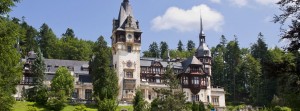 Peleş Castle is one of the most beautiful royal buildings in Europe and also the location of the royal throne of Romania. The castle was built at the request of King Carol I of Romania, following the plans of the architects Johanns Schultz, Carol Benesch and Karel Liman.
Peleş Castle is one of the most beautiful royal buildings in Europe and also the location of the royal throne of Romania. The castle was built at the request of King Carol I of Romania, following the plans of the architects Johanns Schultz, Carol Benesch and Karel Liman.
The castle was decorated by famous artists such as JD Heymann, August Bembe and Bernhard Ludwig. Peleş was built with the personal money of the first king of Romania, Carol I, who wanted to grant his dynasty a castle that would highlight Romania’s new international status. Art specialists consider Peleş to be one of the most important castles raised in Europe in the second half of the nineteenth century. Carol had taken the decision for the construction of the Peles castle in the year of his ascent on the throne. Back then, Carol I was only a Ruling Prince and became Romania’s Sovereign on May 10, 1866. Later that year, in August, he went on to visit Prahova Valley. He discovered there a fairyland near the monastery of Sinaia, a place which reminded him of the mountains of his native Germany. Back then, Sinaia was a simple mountain village, called Podul Neagului and the area in which the Prince Ruler decided to raise his castle was called Piatra Arsă. The area was favoured by King Carol I and was sung in the fairy tales of Romania’s first Queen, Elizabeth, his wife, who became known in literature under the pseudonym Carmen Sylva. Moreover, Peles was elegantly described in the memoirs of the second Romanian Queen, Maria, wife of King Ferdinand I, the grandson on the brother’s side and the successor of King Carol I.
Peleş is where the next Kings of Romania were born: Carol II, son of King Ferdinand I in 1893, and Michael, the son of Carol II and Queen Helen, in 1921. That same year, Peleş hosted the wedding of Princess Ileana of Romania, sister of King Carol II, who became the wife of the Archduke Anton of Austria. Several buildings were built near Peles, out of which the most important are Pelisor and Foisor (the gazebo). The story of Peles began in 1872, when Lord Prince Carol had bought a plot of 1,000 acres. The construction began in 1873. For two years, 300 workers had been working on the premises. In 1875, the cornerstone of the castle was laid by the Prince Ruler himself. Under this stone, there were buried a few coins of 20 lei, the first Romanian coins bearing the image of Carol I, who was to obtain the independence of Romania in 1878, and become the first King of Romania in 1881.
Peleş Castle was inaugurated in 1883 and has hosted many historic events ever since. For example, the Crown Council gathered here after the start of World War I to decide that Romania should remain neutral, a status that was preserved until 1916. After the war ended and after the Great Union of 1918, which brought Transylvania, Maramures, Crisana, Banat, Bukovina and Bessarabia to the Crown, Peleş reached the centre of the country and has remained since the symbolic heart of the Kingdom of Romania.
The castle has 160 rooms and several entrances and staircases. It was the first electrified castle in the world, because it had its own power plant. This allowed the use of numerous innovations. For example, the beautiful glass ceiling of the monumental Hall of Honour, where many royal ceremonies are held, is mobile and can be electrically operated. The lobby is panelled in walnut and numerous bas-reliefs and statues. Also, Peleş Castle had central heating ever since the inauguration of 1883. The castle has a theatre with 60 seats plus the royal box. There is a music room, furnished at Queen Elizabeth’s request. Her furniture was a gift from the Maharajah of Kapurtala. The Royal Library has many rare books, with leather bound covers engraved with golden letters. The Arms Galleries contain more than 4,000 pieces, European and Oriental. There is also a horse and knight armour that is unique in Romania. The Council Room is similar to one of the rooms of Lucerne’s Mayor Hall.
The stained glass of the castle was bought from Switzerland and Germany. The castle has seven terraces decorated with fountains, statues and monumental vases, carved in Carrara marble. The building remained the property of the King of Romania until 1948 when it was confiscated by the communists, and it was returned to His Majesty King Michael I in 2006. The importance of this castle in Romania’s history has been highlighted even by King Michael I: “Peles Castle is a symbol of our country’s independence and power. The most beautiful royal crown is the trust and the love of Romanian and its value lies in Romania’s own merits.”
According to the site familiaregala.ro, “The castle is a symbol of the independent Romanian nation, a unified and consolidated state. From an architectural viewpoint, Peleş Castle is a masterpiece of the German Neo-Renaissance style. Peleş Castle is rather a Palace, whose patios combine Saxon and German elements and whose interior reflects the baroque influence. After the death of Carol I, the castle was bestowed on King Ferdinand, who bequeathed it directly to King Michael “.



